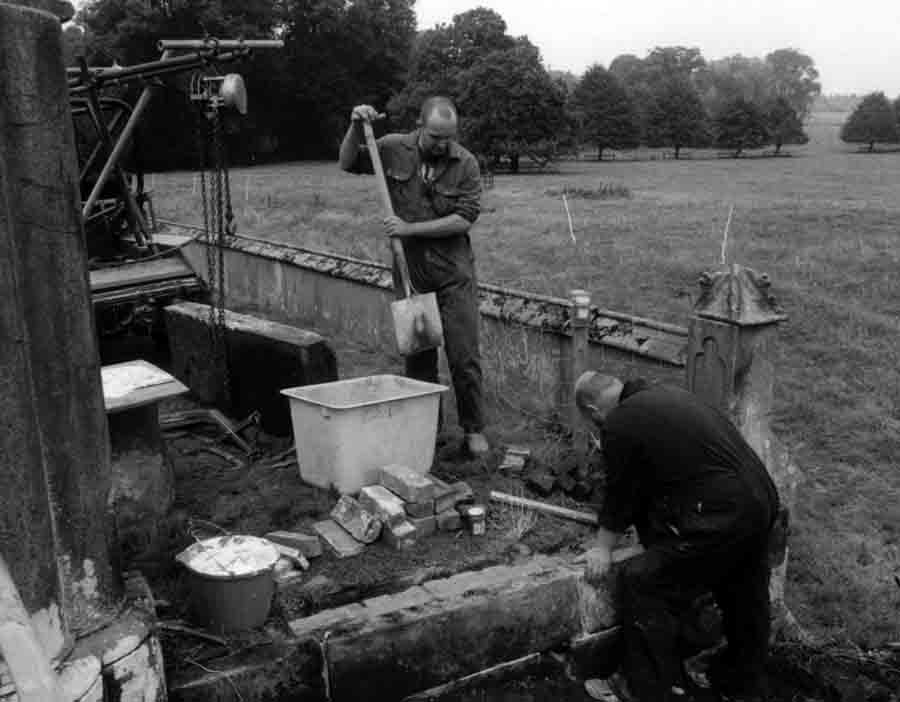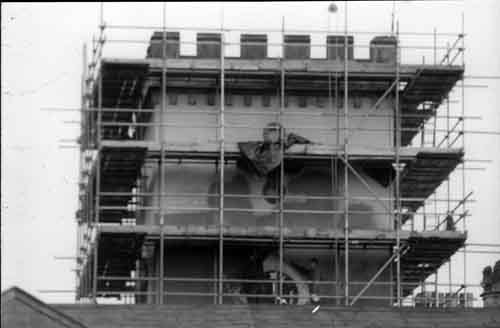Conservation
The repair and conservation of classical buildings involves the use of honest traditional materials lime-mortar/render stone wood plus that most rare ingredient a modicum of common sense.
Repair Methods

The first and most important thing to do with any historic building is to record and the building by means of a photographic survey in 35mm black and white. This is essential before any repair-work commences.
A building survey 1:50 with elevations and sections if need be is the second step to identify various rooms and areas of the building; its useful not just to attach a code or number to that area but to identify historically its function [which may well have varied over time] it becomes so much more practical but sometimes amusing to say “there is an outbreak of dry rot in the servants hall which may have spread from the butler’s pantry” than to struggle with plans and codes. The identification of room functions also assists later when establishing an adaptation or new use for the building.

Before any structural work commences any vegetation soil or debris needs to be removed with extreme care as it can often be acting as a natural means of support to fragile material. Where sections become loose and has to be removed it’s important to carefully number photograph and identify them.
As a general rule it is better to leave well alone; masonry which is weathered or spalled may or may not be aesthetically pleasing but if its is structurally sound and tells the history of the building it is best left.
Where it’s not possible to repair or reinstate new material needs to be utilised: Here there are two schools of thought; the first that material should match as well as possible the surrounding materials and the other that they should contrast, like a well executed patch repair honestly recording wear and weathering. An example would be a fine splicing of an oak dovetail in the worn tread of a staircase or a panel of handmade brickwork or tile on edge inset into a damaged stone wall. Modern materials like reconstituted stone or cementitious products are not generally appropriate to historic repair but can have their uses in additions or adjoining new-work.

Pointing or stucco repairs are often a tricky subject and its often necessary to remove inappropriate modern repair-work which though well meaning has been undertaken using OPC cement and sand; this can prove difficult as the repairs are more often than not too brittle for their application and care has to be taken not to damage the historic material in the process of removal. Reinstatement using lime mortars and renders are preferable using well graded aggregate matching in colour and appearance any older work. Repair work has to dry out slowly and naturally and is vulnerable to sun rain and frost so best covered for some time in hessian to slow the curing process.
After raking-out joints or hacking off loose or defective work masonry best practice is to wash down and leave in a damp state ready for repair; this further aids the slow curing process. Pointing is best executed using pointing-irons as opposed to a trowel; this enables mortar to be pressed well into the joint. Finishing slightly below the surface masonry if possible emulating the style of any original work ribbon/struck/bucket handle etc. work can then be brushed over with a fine stipple afterwards to consolidate.

Cappings copings to parapets and retaining walls are often a source of ingress of damp though joints often causing the upper courses of masonry to become loose. Before removing the loose work it’s necessary to photographically record for reference before cleaning and numbering if need be. When reinstating we try to maintain and if necessary provide good weathering elements weather-drips, tight and well consolidated joints between cappings.
Ashlar work can often suffer exfoliation over time as stonework separates for the rubble-infill this can be tricky to remedy and there are several methods of appropriate repair according to practicality. Stainless steel ties are favourite where possible to stitch the wall back together later with fine grout pumped into the infill.

The key to historic building repair is understanding the use of lime-mortars and stuccos, which are trickier to apply than modern cement based products. Most pre-nineteenth century building utilised lime products.
Limestone (calcium carbonate) when burnt in a kiln, looses carbon dioxide and becomes quicklime (calcium oxide) on contact with water it combines with it producing great heat and forms slaked-lime known as lime-putty (calcium hydroxide) this generally takes up carbon dioxide again from the air and changes back to calcium carbonate. This setting is called carbonisation. Lime putty mixed with sand is what we use to make mortar stucco or render.


